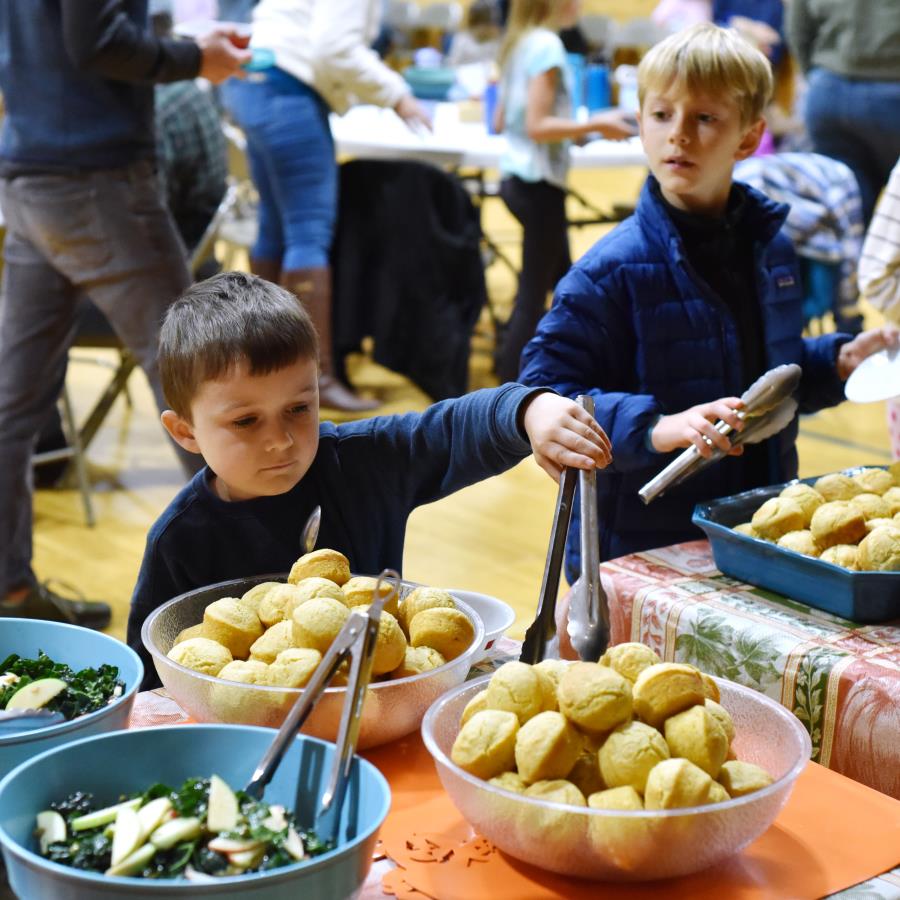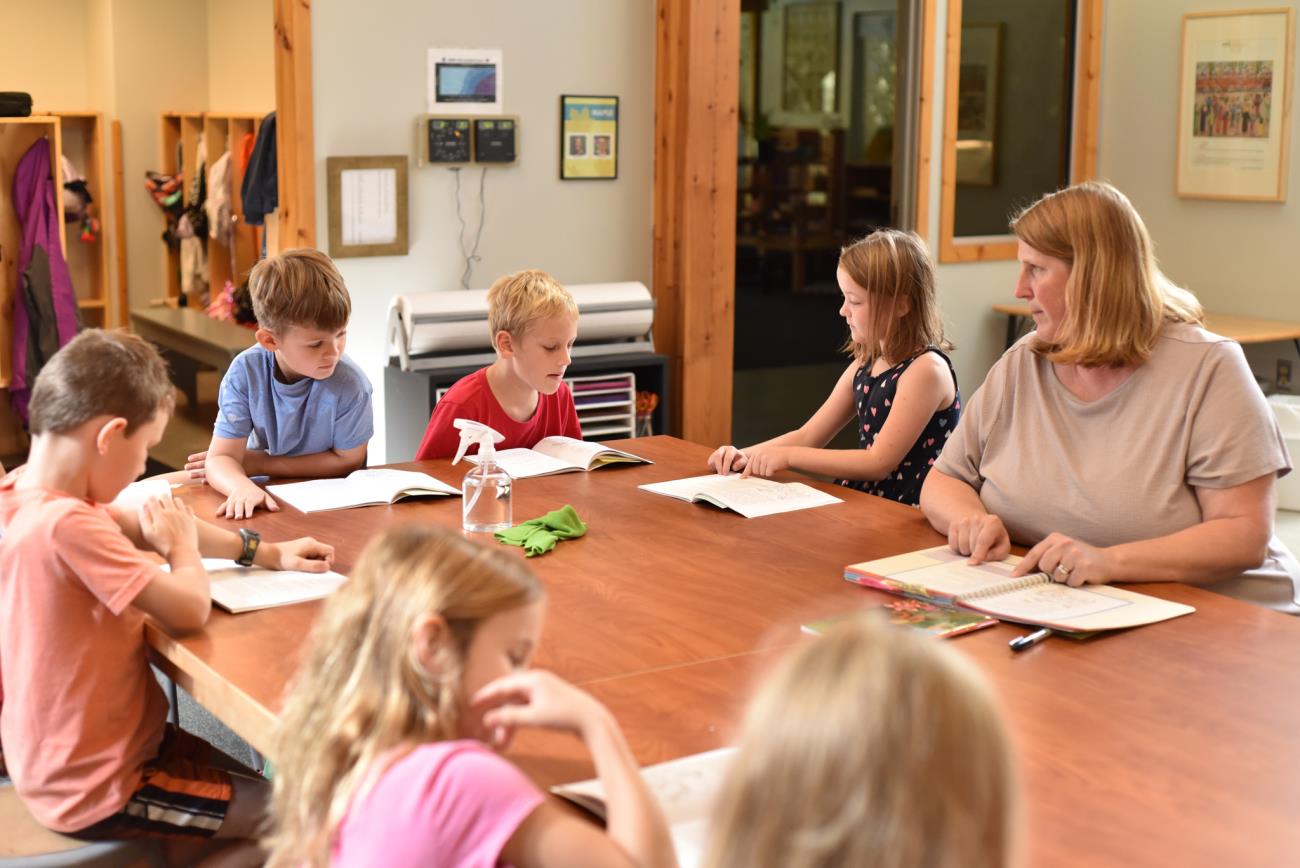As I settle into my third year at The Children’s House, I finally feel I trust myself to take some of our past traditions and modify them to work with the changes that our school has undergone through the years. The many traditions at our school have grown organically, a mish-mash of cultural interests and the love that our staff feels for the children here. The teachers, staff, and administration are always striving to give the children something delightful and meaningful to participate in. The Fall Festival is one such tradition, handed down to the Kitchen Director through the years as a celebration of our Earth to Table program. As I begin to steer not only our kitchen program, but also our greenhouse and gardens (with much help from Steve, DiAnn, and Shea) toward my own interpretation of the Della Terra program, I find myself reflecting on what matters at the heart of the Fall Festival. To me, this meal is a chance for the whole school community to break bread together at the beginning of the year and celebrate our love for this school, each other, and this beautiful place where we live.
Feeding the entire school community, while featuring local produce and our own garden crops requires a lot of planning. We work hard during the week leading up to the festival, and we plan and plant crops in the spring and summer that are harvestable at the end of the season. As far as our own crops go, this year we focused on revamping our garden beds and getting them ready to grow basil and lettuce for the coming school year instead of worrying about supplying bushels of food for the festival. So far, we have made ten gallons of pesto we put up in the freezer for the cold months ahead. The rest of the produce for the meal came from Second Spring Farm, a wonderful organic farm near us in Cedar that has the capacity to keep up with our significant volume needs.
We are so lucky to have such a large and participatory school community here, and it truly warms my heart to feed so many people. While it's difficult to know exactly how many folks ate at the Fall Festival this year, our RSVP numbers were nearly 380 people. During the week we feed around 160 daily, so more than doubling that amount poses some logistical challenges in our already cozy kitchen. The children helped the week leading up to the festival by mixing 10 gallons of corn muffin batter, washing and cutting 30 bunches of kale, slicing a bushel of apples, and blanching and peeling over 50 lbs of paste tomatoes. On Sunday, I whipped up 16 gallons of beef and squash chili while my wonderful friend and chef Emily Stewart, mom to Daniel Stewart and owner of Modern Bird, in addition to donating all of the pumpkin pies, baked off 300 plus muffins and tossed bus tubs full of salad. Many other parents volunteered or stepped in and helped when we needed a hand that day.
As school traditions go, I believe the Fall Festival embodies the values that The Children’s House holds so dear, those of love, growth, and health. One of the reasons this job brings me joy is because of the support I feel from the staff and the parents who trust me and my team to nurture their children every day. I am always interested in finding ways to make the food even better, more locally focused, and seasonal, and I hope in the years to come our garden can contribute significantly to that goal. As I grow more into my role over the years, I hope to both make new and carry on traditions that contribute to our values of love, growth, and health through the food we cook and grow here at The Children’s House.
How does the process of learning to read look in a Montessori classroom? Montessori has what can be called a balanced literacy approach to language. This means that there are both spoken and written components that come together in a variety of ways, over time, and in all areas of our school.
Montessori classrooms are language-rich environments. At every level, children hear a wide variety of words spoken and repeated. It can be the names of clothing needed to go outside or the animals that live in the grasslands of Africa. Songs are sung to help with remembering the names of the continents or learning about being a good friend. Children freely move and interact with one another which gives ample opportunity to listen to what others are saying, practice new words with one another, and share new information. Conversations between child and adult and between child and child are constantly happening in every classroom. Concrete experiences like finding a fossil, baking, slicing bananas, and going down the slide, reinforce the vocabulary taught in Montessori classrooms.
Writing usually begins in the Primary classrooms. There is a very recognizable material called sandpaper letters, which is where the connection between a written letter and a sound is introduced. Another Montessori material, the movable alphabet, is used to teach children about reading and writing. There is not enough room in this blog post to share all the ways that the child’s hand is prepared for writing in Montessori classrooms. Briefly, all of the sensorial and practical life work that the children do is helping to prepare them to write.
In the Elementary environment, lessons continue from prefixes and suffixes to nouns and verbs to support the growing reader and writer. A notable shift begins to happen in older elementary students from learning to read to reading to learn. Yet, learning to read is a process. Many of these steps happen at the same time, or readers move through the steps again and again as they grow their reading skills.
The steps to reading include:
Phonemic awareness: understanding that words are made of sounds. This may look like rhyming, clapping syllables, or thinking of a word that begins with a specific sound.
Phonics and Word Recognition: the connection between the symbol (letter) and sound. This is where spelling lessons, decoding skills like syllable types, and practicing steps to figure out a word are taught.
Fluency: the ability to read words and sentences at a rate similar to speaking. Fluency is an important step to practice because it creates the opportunity to understand what is being read.
Experiencing Rich Text: carefully curated classroom and wing libraries with diverse books to cater to various interests and reading levels. This exposure to different types of literature nurtures a love for reading.
Comprehension: The ability to read a word or sentence and then be able to talk or write about it is the goal of the reading process.
My Montessori training, in addition to training in an Orton-Gillingham approach to systematic reading, allows me to come alongside the teachers and the students to provide support through these different reading steps. Sometimes that looks like materials or lessons coming into the classroom and other times it looks like the student coming for direct lessons with me.
Learning to read is a profound and ongoing process, filled with wonder and discovery. Even as children master the fundamentals, the world of language and literature continues to offer new horizons to explore. Montessori education embraces this journey, nurturing a lifelong love for reading and language.

-1.jpg)
-1.jpg)
